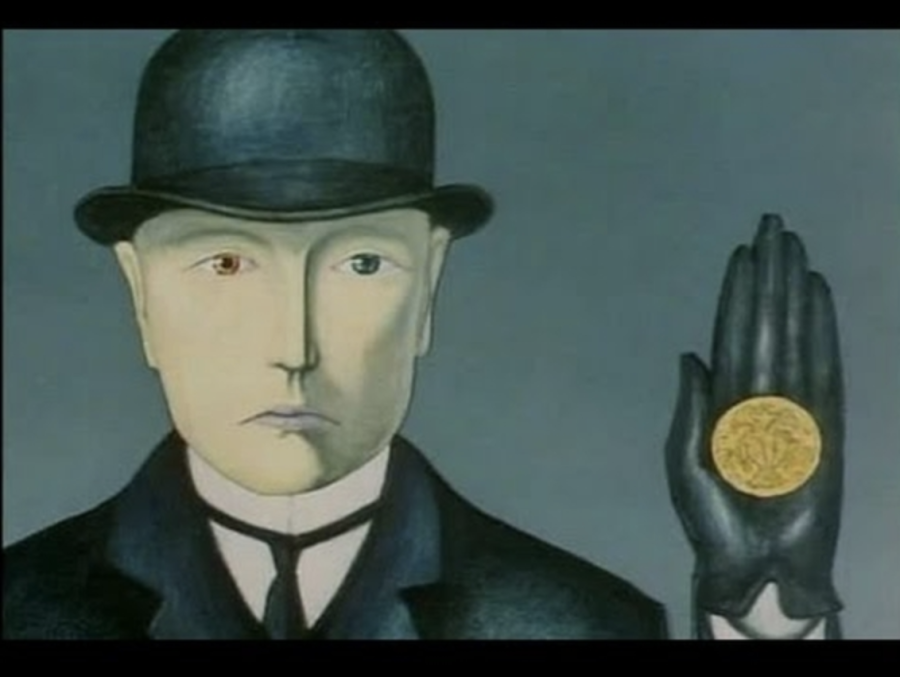The Glass Harmonica Is a Delightfully Curious Short Film, and a Reminder of a Dead Art
March 23, 2023
You’ve probably not heard of The Glass Harmonica or Steklyannaya garmonika. I don’t blame you for not, as it’s a 60’s Soviet short film. But it’s just so delightfully strange that I couldn’t pass up the opportunity to write a piece on it.
The short film tells the tale of a hero, a master craftsman who created the legendary glass harmonica, which has the power to inspire “higher thoughts and actions.” When he arrives at sundown in an unnamed town, he is met by the townsfolk, who pause to listen to the instrument’s beautiful sound. But the craftsman is quickly stopped by the story’s villain, the bowler-hatted bureaucrat with bi-color eyes. The bureaucrat smashes the glass harmonica and rewards a snitch with the “yellow devil,” money in the form of a large coin adorned with the bureaucrat’s head.
While you might come away from the film with an anti-capitalist message, Soviet censors certainly thought differently. It was one of the few animated films censored in the Soviet Union. While The Glass Harmonica’s message certainly aligns with that promoted by Soviet media, perhaps the depiction of an all-powerful bureaucracy and cold, gray society hit too close to home. Perhaps the symbol of the coin in the gloved hand of the shifty bureaucrat could, in the mind of the Soviets, too easily be replaced with a ration card. Perhaps the film’s depiction of the rejection of nature and its replacement by an arbitrary and perverse system revolving around the State paralleled the communist ideology too closely. What is, on the surface, a critique of bourgeois society is perhaps a criticism of the totalitarian and tyrannical Soviet State.
The film’s stunning yet slightly off-putting visuals make it so fascinating. Everything within the fictional world is patently absurd. There’s simply nothing else like it. The movie has the classic animation feel that many new animated films lack. It’s just something about the hazy lighting and bright colors that give it a truly extraordinary feel.
Add a moving soundtrack to the superb visuals, and you’ve got a hell of a short film. The film forgoes dialogue for an impassioned classical soundtrack, which hits like a truck. When the film wants you to feel loss, the soundtrack inspires a longing pain in the heart. The soundtrack gives you goosebumps when the film wants you to feel unsettled. As a silent film, it’s a welcome relief from the cheesy Marvel dialogue that every movie today seems to have.
The Glass Harmonica is a relic of a dead art: true filmmaking. Steklyannaya garmonika wasn’t made with a multi-hundred-million-dollar budget, flashy CGI, and quippy dialogue. It isn’t just another cash-grab reboot of the same worn-out characters progressing through the same story arc. It’s a unique story told with passion by a dedicated master animator and talented composer. That’s why you ought to give it a watch.








trecutul tine minte • May 19, 2025 at 12:46 pm
The film was suppressed in the USSR not because it was anti-socialist, but because it threatened those who had benefitted most from strangling socialism’s core of worker’s democracy in favour of bureaucratic power. Essentially, the film criticises the fact that the USSR was actually in a sort of capitalist competition with the West, as it put aside the main purpose of communism in the first place; a logical and rational assignment of power to workers and not to a central bureaucracy or markets, whether in capitalism or not. Because of this, actual creativity and imagination was postponed for a future date, which never actually came because the West forced the USSR to either become more and more bureaucratised or to completely create a market system, both of which would destroy it, but only the latter would benefit the U$A. Funnily enough you guys complain of cash-grab reboots, but that is the main purpose of the US and its markets. Sucks to live in your own irony.